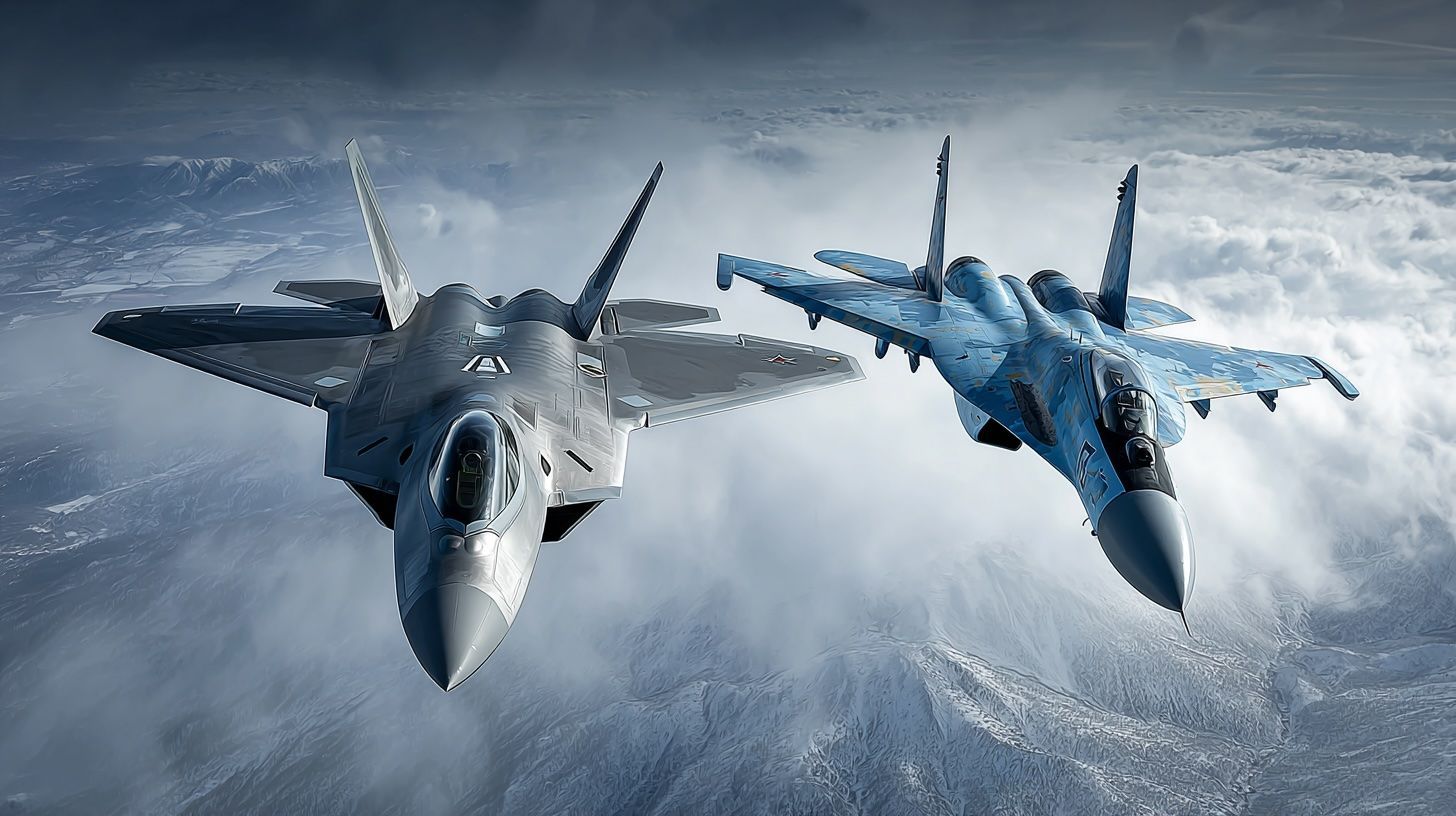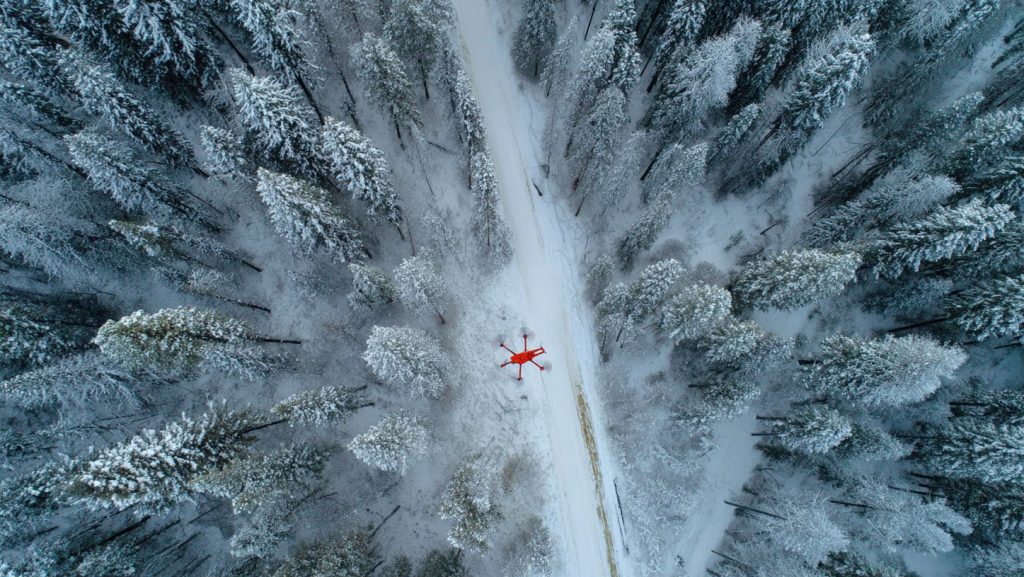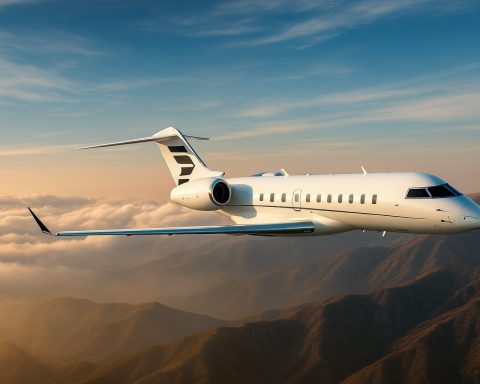- F-35 Lightning II, a 5th-gen stealth fighter, first flew in 2006, entered service in the mid-2010s, and by 2025 had over 1,000 delivered to 17 nations.
- F-22 Raptor, a 5th-gen air-superiority fighter, first flew in 1997 and entered service in 2005, with a top speed around Mach 2.25 and only 195 built.
- Chengdu J-20 Mighty Dragon, a 5th-gen stealth fighter, first flew in 2011 and entered PLAAF service in 2017, with a ferry range near 3,000 nmi and production over 200 aircraft.
- Sukhoi Su-57 Felon, a 5th-gen fighter, first flew in 2010 and entered service in 2020, with thrust-vectoring AL-41F1S engines and about 20 in service by 2024.
- F-15EX Eagle II, introduced to the U.S. Air Force starting in 2021 and in service by 2022–2024, can reach Mach 2.5 and ferry over 2,100 nmi with a payload of up to 22 air-to-air missiles.
- Sukhoi Su-35S Flanker-E, a 4++ generation fighter, first flew in 2008 and entered service around 2014, with Mach 2.25 top speed and roughly 1,500 km combat radius and about 100 in service.
- Dassault Rafale, first flown in 1986 and entered service in 2001, features the SPECTRA electronic warfare suite and 14 hardpoints with a payload of about 9.5 tons.
- Eurofighter Typhoon, first flew in 1994 and entered service around 2003, can reach Mach 2.0+ and carry up to 8 air-to-air missiles with a combat radius about 1,389 km, and over 570 Typhoons are in service.
- Saab JAS 39 Gripen, first flew in 1988 and entered service in 1996, is a lightweight 4+ generation fighter with 8 hardpoints, can carry Meteor missiles, and has a unit cost around $85 million.
- General Dynamics F-16 Fighting Falcon, first flew in 1974 and entered service in 1978, with over 2,000 aircraft in active service worldwide by 2025 and the Block 70/72 variants featuring AESA radar.
An Israeli F-35I stealth fighter takes off during a Red Flag exercise (2023). F-35 Lightning II jets, among others, represent the cutting edge of air dominance in 2025.
Modern fighter jets blend stealth, supermaneuverability, advanced avionics, and heavy firepower to secure air superiority. From fifth-generation stealth fighters to upgraded fourth-generation legends, these aircraft are the pinnacle of military technology in 2025 [1]. Below we highlight the top 10 fighter jets dominating the skies in 2025, comparing their origins, capabilities, and the features that make each a formidable presence. A summary comparison table is provided for at-a-glance analysis, followed by detailed sections for each jet.
Quick Comparison Table of Top 10 Fighter Jets (2025)
| Fighter Jet (Country) | Gen. | First Flight / Intro | Top Speed | Combat Radius | Unit Cost (USD) |
|---|---|---|---|---|---|
| F-35 Lightning II (USA) | 5th | 2006 / 2015 [2] | Mach 1.6 [3] | ~1,100 km (590 nmi) [4] | ~$85 million [5] |
| F-22 Raptor (USA) | 5th | 1997 / 2005 [6] | Mach 2.25 [7] | ~1,600 nmi (ferry) [8] | ~$150 million [9] |
| Chengdu J-20 (China) | 5th | 2011 / 2017 [10] | Mach 2.0 [11] | ~3,000 nmi (ferry) [12] | ~$110 million [13] |
| Sukhoi Su-57 (Russia) | 5th | 2010 / 2020 [14] [15] | Mach 2.0 [16] | ~1,500 km (est.) | ~$45 million [17] |
| Boeing F-15EX Eagle II (USA) | 4++ | 2020 / 2024 | Mach 2.5 [18] | ~2,100 nmi (ferry) [19] | ~$90 million [20] |
| Sukhoi Su-35S (Russia) | 4++ | 2008 / 2014 | Mach 2.25 [21] | ~1,900 nmi (ferry) [22] | ~$85 million [23] |
| Dassault Rafale (France) | 4.5 | 1986 / 2001 | Mach 1.8 [24] | ~1,850 km (with drop tanks) | ~$100 million [25] |
| Eurofighter Typhoon (EU) | 4.5 | 1994 / 2003 | Mach 2.0+ [26] | ~1,800 nmi (ferry) [27] | ~$100 million [28] |
| Saab JAS 39 Gripen (Sweden) | 4+ | 1988 / 1996 [29] | Mach 2.0 [30] | ~1,300 km (with tank) [31] | ~$85 million [32] |
| F-16 Fighting Falcon (USA) | 4 | 1974 / 1978 | Mach 2.0 [33] | ~550 km (mission load) | ~$80 million [34] |
(Approx. first delivery of F-15EX took place in 2021–2022; initial operational unit by 2024.)
1. Lockheed Martin F-35 Lightning II (USA) – Multirole Stealth Mastery
The F-35 Lightning II is a fifth-generation multirole stealth fighter developed by Lockheed Martin (with international partners). It first flew in 2006 and entered service in the mid-2010s [35]. Designed to perform both air-to-air and air-to-ground missions, the single-engine F-35 comes in three variants (A, B, C) for the U.S. Air Force, Marine Corps, and Navy. It features stealthy all-aspect design, internal weapon bays, and advanced sensor fusion, making it hard to detect while providing unparalleled situational awareness to the pilot [36]. The F-35’s Pratt & Whitney F135 engine (the most powerful fighter engine in the world) gives it a top speed of about Mach 1.6 (≈1,975 km/h) [37]. Its combat radius on internal fuel is over 1,090 km for the F-35A [38], allowing strikes deep into enemy territory. Stealth and AN/APG-81 AESA radar, plus the Electro-Optical Targeting System (EOTS), enable the F-35 to track and engage targets before being detected. It carries a mix of advanced weapons like AIM-120 AMRAAM and precision-guided bombs internally (to maintain stealth) or externally in “beast mode” when stealth is less critical.
Despite early criticism over cost (initial unit cost around $100M, now roughly $80–85M for F-35A [39]) and development hurdles, the F-35 has become the most proliferated 5th-gen fighter. Over 1,000 F-35s have been delivered across 17 nations by 2025 [40], forming the backbone of many allied air forces. Its global production and adoption (planned 3,000+ units) have driven costs down and spurred continuous upgrades. The F-35 has seen combat usage in recent years: the Israeli Air Force was the first to use it in combat in 2018, and U.S. F-35s conducted strikes against ISIS by 2019 [41]. In Israeli service, F-35I “Adir” jets have even intercepted adversary drones [42]. With its blend of stealth, data networking, and multirole flexibility, the F-35 Lightning II is often considered the world’s premier fighter in 2025 – a single platform that dominates air-to-air engagements, strikes ground targets, and acts as an intelligence node in networked warfare [43].
2. Lockheed Martin F-22 Raptor (USA) – Air Superiority Stealth Fighter
The F-22 Raptor remains a legendary fighter and gold standard for air superiority even after two decades of service [44]. Developed by Lockheed Martin with Boeing as the USA’s first fifth-generation fighter, the twin-engine F-22 first flew in 1997 and entered service in 2005 [45]. It was designed to own the skies with unmatched stealth, speed, and agility. The F-22’s airframe and coatings give it an extremely low radar cross-section – reportedly as small as a “marble” on radar [46] – making it the stealthiest fighter ever built [47]. Powered by two Pratt & Whitney F119 turbofans with 2D thrust-vectoring nozzles, the Raptor can supercruise at Mach 1.8 (supersonic flight without afterburner) and has a top speed around Mach 2.25 [48]. It has superb maneuverability (thrust-to-weight >1 and vectored thrust) giving it an edge in dogfights. The F-22’s combat radius is roughly 800+ km (it can ferry ~1,600 nmi with drop tanks) [49], sufficient for patrols and deep strikes with aerial refueling.
For avionics, the Raptor carries the AN/APG-77 AESA radar and sophisticated sensor fusion, plus secure datalinks (though its intra-flight data-link was limited to F-22-to-F-22 for stealth reasons). It packs six AIM-120 AMRAAM and two AIM-9 Sidewinder missiles internally for air combat, and can carry JDAMs or Small Diameter Bombs for strike missions when required. The F-22’s unit cost was very high (approx. $150 million flyaway [50]), and only 195 F-22s were built before the program ended in 2011 due to budget and the inability to export [51]. Despite this, it’s widely regarded as the most dominant air-to-air fighter. In service, F-22s have never been defeated in mock air combat, and they detered adversaries just by presence. Raptors saw limited combat in ground-attack roles over Syria – notably in 2014–2015 they struck ISIS targets and enforced no-fly zones, all while operating under the umbrella of advanced enemy air defenses without a scratch [52]. Pilots often report that in exercises, F-22s can engage enemies “before the enemy even knows they’re there.” Its only real drawbacks are maintenance complexity and aging electronics. The USAF has upgrade programs underway to add better datalinks, electronic warfare improvements, and new missiles (like the AIM-260 JATM) to keep the Raptor lethal into the 2030s [53]. In 2025, the F-22 remains virtually untouchable in air dominance, pairing with newer jets like the F-35 to ensure U.S. air superiority.
3. Chengdu J-20 “Mighty Dragon” (China) – China’s Stealth Air Superiority Jet
China’s Chengdu J-20 Mighty Dragon has rapidly risen as one of the world’s elite fighter jets, showcasing China’s aerospace leap. It is a fifth-generation twin-engine stealth fighter that first flew in 2011 and entered PLAAF service by 2017 [54]. The J-20 is a large fighter (~20+ meters long) built for long-range air superiority and strike missions. Its design emphasizes frontal-aspect stealth – a chiseled nose, frameless canopy, blended fuselage, and all-moving canard-delta configuration to reduce radar signature from head-on [55] [56]. While possibly less stealthy on the sides or rear than an F-22, it is still very stealthy from the front. Initially, early J-20s used Russian AL-31F engines, but newer production has Chinese WS-10C engines, and a more powerful WS-15 with thrust vectoring is in development [57]. With current engines, the J-20 can reportedly supercruise around Mach 1.7+; top speed is estimated around Mach 2.0 [58]. Thanks to its large internal fuel, its range is enormous – about 3,000 nmi (≈5,550 km ferry range) [59] – giving China the ability to project power far into the Western Pacific. Combat radius is believed to exceed 1,500 km, crucial for covering areas like the South China Sea or Taiwan Strait.
The J-20 carries an AESA radar and advanced electronics, though details are secret. It likely has IRST (infrared search & track) for passive detection and a datalink network for coordination with other assets (and possibly with stealth drones in future). The J-20’s internal weapon bay can house long-range air-to-air missiles like the PL-15 (estimated 200+ km range) and PL-10 high-off-boresight IR missiles, giving it a powerful first-shot capability. Notably, the J-20 can carry large anti-ship or cruise missiles internally as well, making it a dual threat to both fighters and warships. With China’s emphasis on production, over 200 J-20s are already operational – surpassing the F-22’s production run [60] – and monthly output remains high [61]. China keeps the J-20 for its own use (no exports), integrating it into tactics to challenge U.S. air dominance in Asia [62]. While it hasn’t seen combat, the J-20 is active in peacetime operations, such as patrols near Taiwan and encounters with U.S. surveillance aircraft in the East China Sea. It reportedly surprised an American F-35 in one close encounter, showing up unexpectedly on its wing in 2022 – a sign of China’s growing confidence in the type. The Mighty Dragon represents China’s coming of age: a stealth fighter designed to counter the F-22 and F-35, with long reach and advanced weaponry, fundamentally altering the balance of power in the skies over the Western Pacific [63].
4. Sukhoi Su-57 “Felon” (Russia) – 5th-Gen Fighter with Supermaneuverability
Russia’s Sukhoi Su-57, NATO codename “Felon”, is a fifth-generation multirole fighter and the Kremlin’s answer to the F-22/F-35. The Su-57 had its maiden flight in 2010 and achieved initial service entry in late 2020 [64] [65]. As Russia’s first stealth fighter, the Su-57’s design philosophy balances stealth with traditional Russian strengths in kinematics. It features stealthy elements – a flattened fuselage, internal weapons bays, canted tailfins, and composite materials – aimed primarily at reducing frontal radar cross-section [66]. However, by Western standards its stealth is limited; experts note it is less stealthy overall than F-22/F-35, especially from side and rear angles [67] [68]. Sukhoi prioritized supermaneuverability: the Su-57 has thrust-vectoring AL-41F1 engines, providing extreme agility and post-stall maneuver capability (e.g. tight loops, the famous “cobra” maneuver). It can reach about Mach 2 top speed (≈2,470 km/h) and supercruise at around Mach 1.6 [69]. The fighter’s range is thought to be roughly 1,500–2,000 km in combat, extended by aerial refueling. In terms of avionics, the Su-57 is equipped with the Sh121 multi-band AESA radar system (including cheek side-array radars for wide coverage) and an advanced IRST for passive tracking. Its sensor fusion and cockpit tech are a leap for Russia, including a HUD and helmet-mounted sight for high-off-boresight missile shots.
The Su-57 carries a hefty weapons load: up to four long-range R-77M (AA-12) or upcoming R-37M air-to-air missiles internally, plus two shorter-range IR missiles in side bays. It can also tote anti-ship or air-to-surface missiles and guided bombs internally or on external pylons (sacrificing stealth). A key advantage is cost – estimated unit price around $40–50 million, roughly one-third of an F-35 [70] – but that comes with Russia’s economic and sanction constraints. Only about 20 operational Su-57s exist as of late 2024 [71] [72], far below initial plans, due to funding and production challenges. Nevertheless, Russia has deployed the Su-57 in limited combat roles: it reportedly conducted some airstrike missions in Syria in 2018 (dropping stand-off munitions) and has been used during the Ukraine conflict primarily as a long-range missile shooter from protected airspace [73]. Moscow keeps the Felons away from high-threat environments to avoid losses and prying eyes. Despite the low numbers, the Su-57 is a technologically significant step for Russia – combining stealth features with extreme maneuverability [74]. Its presence signals Russia’s determination to remain a player in advanced air combat. Future improvements (like new Izdeliye 30 engines for better thrust and reliability) and exports to partners like India (or others, if relations allow) could increase its impact. In 2025, the Su-57 “Felon” is a lethal machine on paper – and though it hasn’t proven itself in a high-end fight, it sends a message that Russia can field a fifth-gen fighter to challenge Western airpower.
5. Boeing F-15EX Eagle II (USA) – Heavily Armed Next-Gen Eagle
The F-15EX Eagle II is the latest evolution of the famed F-15 Eagle – a fourth-generation air superiority fighter originally introduced in the 1970s, now reincarnated with 21st-century tech. First delivered in 2021, the F-15EX began equipping the U.S. Air Force in 2022–2024 as a replacement for aging F-15C/Ds [75]. Externally it resembles its predecessor, but under the skin the F-15EX has state-of-the-art avionics and weapons capacity. It features a new APG-82 AESA radar, an advanced digital cockpit with large area displays, modern fly-by-wire controls, and the EPAWSS electronic warfare suite for improved survivability [76]. Notably, the Eagle II retains the twin Pratt & Whitney F100 engines (or optionally GE F110s) with tremendous thrust, allowing it to reach speeds of Mach 2.5 – making it one of the fastest fighters in the world [77]. Its operational range is also excellent: with conformal fuel tanks, it can ferry over 2,100 nmi (≈3,900 km) [78] and has a combat radius well above 1,000 km, giving it long legs for homeland defense or strike escort missions.
Where the F-15EX truly shines is payload. It is dubbed the “missile truck” – capable of carrying up to 22 air-to-air missiles (when using new weapon racks) or a mix of bombs and missiles totaling nearly 13.6 tons of ordnance [79]. This is the highest weapons capacity of any fighter in production [80]. For air combat, it can haul more AMRAAMs or future AIM-260 missiles than any stealth fighter, making it an ideal arsenal plane to accompany F-35s or F-22s (which designate targets) [81]. It can also carry hefty air-to-ground loads (Joint Direct Attack Munitions, Small Diameter Bombs, anti-ship missiles, etc.), giving it strike prowess. While the F-15EX lacks stealth, it compensates with speed, altitude, and electronic countermeasures – it doesn’t sneak in, it bludgeons in with overwhelming firepower and then exits quickly [82]. The USAF plans to buy at least 144 F-15EXs (at about $87 million each flyaway [83]) to refresh its fleet [84], ensuring the Eagle lineage flies into the 2050s. Early units are already flying (the first F-15EX arrived in 2021, and by mid-2024 eight were delivered with more in production [85]). The F-15EX has not yet seen combat, but its predecessor, the F-15C/E, boasts an unrivaled air-to-air record (100+ kills, 0 losses) and extensive combat in wars from Desert Storm to the War on Terror. This heritage plus new capabilities make the Eagle II a potent deterrent. In warfighting scenarios, F-15EXs might fly alongside stealth fighters, slinging missiles from standoff ranges or performing defensive counter-air sweeps with sheer magazine depth. In 2025, the F-15EX proves that an updated classic can still dominate – it’s effectively the most heavily armed operational fighter and the fastest in the U.S. fleet, ensuring that the USAF can cover missions where stealth isn’t required but brute force is [86].
6. Sukhoi Su-35S “Flanker-E” (Russia) – Supermaneuverable 4++ Generation Fighter
The Sukhoi Su-35S is often regarded as the apex of non-stealth fighter design – a thoroughly modernized derivative of the Su-27 Flanker, packing advanced avionics and awe-inspiring maneuverability. Designated a “4++ generation” fighter, the single-seat Su-35S first flew in 2008 and entered Russian service in the mid-2010s (around 2014). It remains a key air superiority asset for Russia, and is also in service with China and Egypt [87]. The Su-35S is powered by two AL-41F1S turbofan engines with 3D thrust vectoring nozzles, which give it exceptional agility. It can execute dramatic post-stall maneuvers like the famous “Pugachev’s Cobra” and “Kulbit” somersault, useful for evading missiles or winning close dogfights [88]. With each engine putting out 14.5 tons of thrust, the Su-35S can achieve Mach 2.25 top speed (≈2,500+ km/h) and boasts a thrust-to-weight ratio over 1, even fully loaded [89]. Its climb rate and acceleration are among the best of any fighter. The range is also impressive: thanks to large internal fuel tanks, the Su-35 has a ferry range over 3,500 km (about 1,900 nmi) [90] and can patrol long distances; its combat radius (with air-to-air load) is on the order of 1,500 km, very useful for a country as vast as Russia.
Avionics-wise, the Su-35S features the Irbis-E passive electronically scanned array (PESA) radar, which, while not AESA, is extremely powerful – it can detect a fighter-sized target at up to 400 km distance under optimal conditions [91]. This long reach radar, combined with an Infrared Search and Track (IRST) system, gives the Su-35 the ability to track stealthier targets via radar or heat signature. The cockpit is upgraded with digital displays and HOTAS controls, though Russian avionics still lag slightly behind Western counterparts in interface. The Su-35 carries a formidable weapons load on its 12 external hardpoints – up to 8,000 kg of ordnance [92]. This can include R-77 and R-27 air-to-air missiles, ultra-long-range R-37M missiles for AWACS/killer role, as well as a variety of air-to-ground munitions, anti-ship missiles, and rockets. In essence, it’s a true multirole fighter, although its primary design is air superiority. With an estimated unit cost around $85 million [93], the Su-35S is expensive for a non-stealth jet, but considerably cheaper than 5th-gen planes. Russia has about 100 Su-35S in service [94] and has exported some (China operates 24, Egypt has begun receiving theirs). Notably, Su-35s have seen combat in Syria providing air cover and striking ground targets, and they are heavily involved in the 2022–2023 conflict in Ukraine – where they’ve been credited with multiple beyond-visual-range kills against Ukrainian aircraft, thanks to their powerful sensors and missiles (though also one Su-35 was reportedly shot down by Ukrainian air defenses). In exercises, the Su-35 has proven it can challenge even F-15s and Eurofighters in close-in engagements due to its agility. Its combination of speed, range, agility, and firepower makes it arguably the most capable fourth-gen fighter in service. While it cannot hide like a stealth jet, in capable hands and with support the Su-35S “Super Flanker” remains a legitimate threat even to newer designs [95], ensuring Russia and its clients have a razor-sharp spear tip in the air.
7. Dassault Rafale (France) – “Omnirole” Fighter with Electronic Warfare Prowess
The Dassault Rafale is France’s premier fighter, known for its versatility (“omnirole” capability) and advanced electronics. Developed in the late Cold War as a replacement for multiple French aircraft, the Rafale first flew in 1986 and entered service in the early 2000s (2001 for the Navy F1 version, 2004 for Air Force). This twin-engine 4.5-generation jet has a delta wing with close-coupled canards, giving it superb agility and lift. It is capable of Mach 1.8 top speed (around 2,000 km/h) and supercruise at lower supersonic speeds when in air-to-air configuration [96]. The Rafale’s combat range is excellent: with drop tanks, it can perform deep strike missions over 1,850 km away, and it has in-flight refueling capability for extended reach [97]. A key design aspect is its high degree of payload flexibility – it has 14 hardpoints (on Rafale B/C) and can carry ~9.5 tons of weapons/fuel, allowing mixed loadouts (air-to-air missiles, bombs, pods, etc.) for multiple mission types in one sortie.
Where the Rafale truly stands out is avionics and sensor fusion. It features the Thales RBE2 AA AESA radar (in latest F3R/F4 variants), providing excellent tracking of multiple targets and high resistance to jamming. It was also one of the first fighters with an integrated Infrared Search and Track (OSF) and full sensor fusion to present a coherent tactical picture. The Rafale’s hallmark is the SPECTRA electronic warfare suite, an onboard system that can detect and jam or deceive enemy radars and missiles. SPECTRA gives the Rafale a degree of survivability approaching stealth – some say it is “electronically stealthy,” able to confuse enemy sensors and reduce likelihood of being hit [98]. The Rafale can thus operate in high-threat environments despite not having a stealth airframe. In armament, Rafale carries MBDA Meteor long-range air-to-air missiles (giving it a BVR punch >100 km range) and MICA missiles for both radar and IR homing (effective at within-visual-range combat). For ground attack, it deploys SCALP-EG stealth cruise missiles, AASM “Hammer” guided bombs, laser-guided bombs, and even nuclear stand-off missiles (the Air Force Rafale can deliver the ASMP-A nuclear missile for France’s deterrent). It also can carry Exocet or AM39 anti-ship missiles, truly an all-purpose loadout. The latest Rafale F4 standard under development is adding improved connectivity (network-centric warfare capabilities) and upgraded sensors to detect stealthy targets at long range [99].
The Rafale has proven itself in combat over the past two decades. French Rafales saw extensive action in Afghanistan, Libya (2011), Mali, Iraq, Syria, and other theaters [100], often performing precision strikes and air superiority missions on the same sortie. Its reliability and effectiveness have driven export success: India, Egypt, Qatar, Greece, and more recently the UAE and Indonesia have purchased Rafales, bringing total orders to over 500 units [101]. The unit price is around $100 million (varying by contract and included weapons) [102], making it one of the pricier 4.5-gen fighters, but buyers cite its “two-in-one” capability (able to replace separate fleets of fighters and bombers). In the 2020s, the Rafale remains one of the most balanced fighters – fast, nimble, with a wide array of weapons and extremely advanced electronic warfare. It may lack stealth shaping, but French ingenuity with SPECTRA means a Rafale can be a nasty surprise for opponents who think they’ve locked onto it. The Rafale’s performance in exercises and Red Flag scenarios has been excellent, often matching or besting other 4.5-gen jets. As an omnirole platform, the Rafale exemplifies what a cutting-edge non-stealth fighter can do – adapt to any mission and excel, truly a “gust of wind” sweeping through the battlefield.
8. Eurofighter Typhoon (UK/Germany/Italy/Spain) – European Multirole Powerhouse
The Eurofighter Typhoon is Europe’s flagship 4.5-generation fighter, born from a consortium of four nations (UK, Germany, Italy, Spain) to develop an advanced air-superiority jet that could also perform strike missions. First flying in 1994 and entering service in the early 2000s, the Typhoon has since been continually upgraded. It features a distinctive delta wing with foreplane canards and was designed with relaxed stability and fly-by-wire controls for agility [103]. The result is superb maneuverability and acceleration. With twin Eurojet EJ200 afterburning turbofans, the Typhoon can supercruise at around Mach 1.5 and reach a max speed of Mach 2.0+ (it has been recorded at about Mach 2.0–2.2 in level flight) [104]. Its thrust-to-weight ratio is one of the best among fighters (around 1.15 with typical load [105]), enabling quick climbs and sustained turns. The Typhoon’s range on internal fuel is decent – about 1,389 km combat radius for interception – but with drop tanks it ferries about 1,800 nmi (3,300 km) [106]. New conformal fuel tanks in development will further extend its range for long patrols.
Originally conceived purely for air superiority, the Typhoon was later adapted to multirole operations. It carries a CAPTOR radar (mechanically scanned array in earlier Tranche 1/2, and now being upgraded to CAPTOR-E AESA in later tranches) for robust air and ground tracking. A hallmark of the Typhoon is its sensor suite and data fusion: it integrates the PIRATE infrared search and track sensor (useful for passive detection of stealthy or low-flying targets) and the Defensive Aids Sub-System (DASS) for electronic countermeasures [107]. This gives the pilot comprehensive situational awareness. In armament, the Typhoon is a beast: it typically carries up to 8 air-to-air missiles (e.g. 4 long-range Meteors + 4 short-range ASRAAM/IRIS-T) and a centerline cannon. It can also lug a wide variety of bombs (Paveway laser-guided, JDAMs) and standoff missiles (Storm Shadow cruise missiles, Brimstone anti-armor missiles) for strike missions. Future integration of the Spear-3 cruise missile and other advanced weaponry is planned. With up to ~9 tonnes of payload capacity, it can rival the Rafale in bomb load. What sets Typhoon apart is its performance in air combat: pilots frequently praise its high-altitude, high-speed capabilities, and in dogfight exercises Typhoons have held their own against F-22s (using high off-boresight missiles to compensate where needed).
The Typhoon has seen active service in policing and combat. Eurofighters of various nations have performed Baltic Air Policing (intercepting Russian aircraft in Europe), were deployed in the Libya 2011 intervention (UK and Italy used Typhoons in both air-to-air and air-to-ground roles), and have struck ISIS targets in Syria/Iraq (RAF Typhoons carrying out precision bombing). Over 570 Typhoons are in service across Europe and the Middle East [108], including with Germany, UK, Italy, Spain, Austria (air defense only), Saudi Arabia, Qatar, and Kuwait. With an approximate flyaway cost of $90–120 million (export customers pay on the higher end) [109], it’s an expensive system. However, its consortium model means partner nations got advanced capabilities at cost price for themselves. The Eurofighter program plans to keep the jet relevant into the 2040s, with ongoing upgrades like the advanced AESA radar, improved electronics, and possibly thrust-vectoring in future [110]. In 2025, the Typhoon stands as a linchpin of NATO airpower, combining agility, powerful sensors, and heavy multirole armament. It might not be stealth, but with tactics and electronic warfare, Typhoons are proven to be a formidable challenge to any opponent, ensuring European skies remain well-guarded.
9. Saab JAS 39 Gripen (Sweden) – Agile and Affordable “Smart Fighter”
Sweden’s Saab JAS 39 Gripen is a unique entry among top fighters – a lightweight, cost-effective yet highly sophisticated 4+ generation jet often called the “smart fighter.” Developed to be affordable, easy to maintain, and lethal in Sweden’s defense concept, the Gripen first flew in 1988 and entered service in 1996 [111]. “JAS” stands for Jakt (air-to-air), Attack (air-to-ground), Spaning (recon) – reflecting its multirole design. The latest iteration, the Gripen E (single-seat) and F (two-seat), brings major advancements making it competitive with heavier 4.5-gen fighters. Gripen’s design features a delta wing and forward canards (like Rafale and Typhoon), giving it excellent maneuverability and short-field performance. Despite having one engine (a Volvo RM12 on earlier C/D versions and GE F414 on new E version), it can reach Mach 2.0 at altitude [112]. Its small size and efficient design yield a combat radius around 800 km (with reserves) and a ferry range up to 4,000 km with drop tanks [113]. Notably, Gripen was built to operate from austere bases – even highways – with minimal crew, aligning with Sweden’s strategy of dispersal. Turnaround time for rearming and refueling is famously short (a few ground crew can rearm it in under 10 minutes).
Avionics are where Gripen punches above its weight. It was among the first fighters to have networked data-links allowing fighters to share targeting data seamlessly – a feature so effective that NATO pilots remarked how Swedish Gripens in Red Flag exercises seemed to “see” everything in the air. The newest Gripen E carries the Leonardo Raven ES-05 AESA radar, a modern IRST (SkyWard-G), and an electronic warfare suite that is extremely capable for its class [114]. Saab emphasizes electronic warfare and countermeasures, giving the Gripen strong defensive aids for its size. The Gripen’s cockpit is highly ergonomic with modern Wide Area Displays (in Gripen E) and advanced pilot decision-aiding systems (some AI-driven suggestions for tactics, earning it the moniker “smart fighter” [115]). In terms of armament, the Gripen can carry most Western weapons: AIM-120 AMRAAM, AIM-9X/IRIS-T, and importantly the MBDA Meteor long-range missile – Sweden was a launch customer for Meteor, which gives even a light fighter like Gripen a beyond-visual-range punch rivaling bigger jets. It can also deploy guided bombs, anti-ship missiles (RBS-15), and reconnaissance pods, truly multi-role. The Gripen’s payload is smaller (around 5–6.5 tons on 8 hardpoints), but its smaller radar cross-section and agility compensate by allowing it to engage on its own terms.
One of Gripen’s biggest selling points is operating cost and reliability. Its hourly flight cost (around $7,500) is a fraction of twin-engine rivals [116]. This appeals to many smaller air forces. Sweden operates ~90 Gripen C/D and is transitioning to 60 new Gripen Es. Export users include Brazil (started receiving Gripen E in 2022–2023), South Africa, Hungary, Czech Republic, and Thailand. In NATO exercises, Gripens have achieved favorable kill ratios, leveraging their excellent avionics and Meteors. While not used in high-intensity war by Sweden, Gripens did participate in the Libya 2011 campaign (flown by the Swedish Air Force for recon missions). They also perform NATO air-policing in Europe under lease agreements (e.g. Czech and Hungarian Gripens guarding the Baltics). The latest Gripen E has an estimated unit cost of $85 million [117] – not “cheap” per se, but cheaper to buy/operate than most contemporaries, especially given its advanced tech. In summary, the JAS 39 Gripen is an ultra-agile, network-centric fighter that proves you don’t need a heavyweight platform to dominate the skies. In 2025, Gripen stands out as the fighter of choice for nations wanting top-tier capabilities on a budget, offering a potent mix of modern sensors, low operating cost, and multi-role flexibility that keeps it relevant even as stealth fighters emerge.
10. General Dynamics F-16 Fighting Falcon (USA) – Iconic Workhorse with Upgraded Bite
The F-16 Fighting Falcon, often called the “Viper” by pilots, is the oldest design on this list – yet it continues to dominate the global fighter scene through continual upgrades and sheer ubiquity. Developed in the 1970s as a lightweight dogfighter, the single-engine F-16 first flew in 1974 and entered USAF service in 1978. Fast forward to 2025: the F-16 has evolved into a fully multirole 4th-generation+ fighter, with the latest F-16V (Viper) Block 70/72 variant boasting modern avionics that keep it combat-relevant [118]. Over 2,000 F-16s remain in active service worldwide – more than any other fighter model [119] – arming the air forces of 25+ countries. This widespread use and continuous block upgrades earn the F-16 a spot among the top jets even in 2025.
The F-16’s design is characterized by its blended wing-body, bubble canopy for excellent visibility, and relaxed stability with fly-by-wire – a novelty when introduced. It remains a nimble dogfighter, capable of pulling 9G turns and agile maneuvers. With its Pratt & Whitney F100 (or GE F110) engine, the F-16 can reach Mach 2.0 and has a thrust-to-weight ratio near 1:1 in clean configuration [120]. Its combat radius is moderate (around 500–600 km on interdiction missions), but it can carry drop tanks and now conformal fuel tanks to extend range for strikes. The Block 70/72 F-16V upgrade adds the Northrop Grumman AN/APG-83 AESA radar, a new mission computer and cockpit displays, JHMCS helmet-mounted sight, and integration of advanced weapons [121]. These enhancements essentially make the F-16 a 4.5-gen jet in terms of electronics. It can employ the AIM-9X and AIM-120D air-to-air missiles, JDAMs, JSOW, anti-ship missiles (Harpoon), HARM anti-radiation missiles, and various pods (SNIPER targeting pod, etc.), covering every mission from SEAD (Suppression of Enemy Air Defenses) to precision strike and air patrol. An F-16 can carry up to 7,700 kg of ordnance across 9 hardpoints [122] – including 6× 500 lb bombs + missiles, or larger bombs, giving it considerable punch for its size.
The combat pedigree of the F-16 is extensive. It has served as the workhorse for the U.S. and many allies in conflicts: from the Gulf War 1991 (where F-16s flew countless strike sorties) to Kosovo 1999, Iraq and Afghanistan wars, and various Middle East conflicts. The Israeli Air Force in particular has utilized F-16s in multiple wars and air strikes (including the famous 1981 Osirak nuclear reactor strike and many operations since). F-16s have scored air-to-air kills in conflicts (over 70 kills in various air forces, against minimal losses in air combat). Its latest variants have not engaged in a peer conflict, but upgrades like the F-16V ensure it could hold its own, especially as part of a coalition. The F-16’s affordability (approx. $70–$80M new [123]) and ease of maintenance also mean it’s likely to serve into the 2030s. Notably, in 2023–2024, discussions arose about transferring F-16s to Ukraine to bolster its defense – highlighting that even against modern threats, a squadron of well-equipped F-16s is a serious reinforcement.
In 2025, the Fighting Falcon is still soaring high: It’s the most widely used fighter in the world [124], and continuous improvements (AESA radar, new weapons, datalinks) keep it lethal. The F-16 exemplifies adaptability – an originally simple dogfighter that became a multi-mission beast. Pilots laud its handling and powerful F100/F110 engine that make it a joy (and menace) in aerial combat. With thousands in service, the F-16’s presence is felt in almost every global hotspot, truly making it a cornerstone of global air power and an iconic fighter of our time.
Bottom Line: Dominating the skies in 2025 are these ten fighters – each a pinnacle of engineering in its category. From the all-seeing stealth of the F-35 and J-20 to the raw kinematic power of the Su-35 and F-15EX, these jets define modern air combat capabilities [125] [126]. They hail from different nations but share common traits: high speed, advanced sensors, potent weaponry, and the ability to multitask across air superiority, strike, and more. Many have faced off indirectly in conflict zones or exercises, informing the constant evolution of tactics and technology. As geopolitical tensions persist, these fighters serve not just as weapons but as strategic deterrents and symbols of national power. Ongoing developments – like software upgrades, new missiles (e.g., Meteors, AIM-260), and improved electronic warfare – ensure that even 4th-gen platforms remain credible alongside the latest stealth jets. Looking ahead, while sixth-generation fighters loom on the horizon for the 2030s, the aircraft on this list will continue to form the backbone of air forces worldwide for years to come. Their dominance in 2025 is the result of decades of innovation and the relentless pursuit of air superiority, ensuring that whoever controls the skies can shape the outcome of any conflict.
Sources: The information above has been compiled and cross-verified from defense analysis reports, official fact sheets, and expert commentary, including Aviation Week, AeroTime, Aviation A2Z, and open-source military data [127] [128] [129] [130]. Each jet’s specifications and service record are supported by these sources, as indicated throughout the text.
References
1. aviationa2z.com, 2. en.wikipedia.org, 3. www.aerotime.aero, 4. www.lockheedmartin.com, 5. aviationa2z.com, 6. en.wikipedia.org, 7. aviationa2z.com, 8. www.aerotime.aero, 9. aviationa2z.com, 10. commons.wikimedia.org, 11. www.aerotime.aero, 12. www.aerotime.aero, 13. www.aerotime.aero, 14. en.wikipedia.org, 15. en.wikipedia.org, 16. aviationa2z.com, 17. aviationa2z.com, 18. aviationa2z.com, 19. www.aerotime.aero, 20. www.aerotime.aero, 21. www.aerotime.aero, 22. www.aerotime.aero, 23. www.aerotime.aero, 24. www.aerotime.aero, 25. aviationa2z.com, 26. www.aerotime.aero, 27. www.aerotime.aero, 28. www.aerotime.aero, 29. en.wikipedia.org, 30. www.aerotime.aero, 31. en.wikipedia.org, 32. www.aerotime.aero, 33. www.aerotime.aero, 34. www.aerotime.aero, 35. en.wikipedia.org, 36. www.aerotime.aero, 37. aviationa2z.com, 38. www.lockheedmartin.com, 39. aviationa2z.com, 40. aviationa2z.com, 41. en.wikipedia.org, 42. www.defensenews.com, 43. aviationa2z.com, 44. aviationa2z.com, 45. en.wikipedia.org, 46. www.aerotime.aero, 47. www.aerotime.aero, 48. aviationa2z.com, 49. www.aerotime.aero, 50. aviationa2z.com, 51. www.aerotime.aero, 52. aviationa2z.com, 53. aviationa2z.com, 54. commons.wikimedia.org, 55. aviationa2z.com, 56. aviationa2z.com, 57. aviationa2z.com, 58. www.aerotime.aero, 59. www.aerotime.aero, 60. aviationa2z.com, 61. www.aerotime.aero, 62. aviationa2z.com, 63. aviationa2z.com, 64. en.wikipedia.org, 65. en.wikipedia.org, 66. aviationa2z.com, 67. www.19fortyfive.com, 68. www.19fortyfive.com, 69. aviationa2z.com, 70. aviationa2z.com, 71. www.19fortyfive.com, 72. www.19fortyfive.com, 73. www.19fortyfive.com, 74. www.19fortyfive.com, 75. aviationa2z.com, 76. aviationa2z.com, 77. aviationa2z.com, 78. www.aerotime.aero, 79. aviationa2z.com, 80. aviationa2z.com, 81. www.aerotime.aero, 82. www.aerotime.aero, 83. aviationa2z.com, 84. aviationa2z.com, 85. www.aerotime.aero, 86. www.aerotime.aero, 87. aviationa2z.com, 88. aviationa2z.com, 89. aviationa2z.com, 90. www.aerotime.aero, 91. aviationa2z.com, 92. aviationa2z.com, 93. www.aerotime.aero, 94. aviationa2z.com, 95. aviationa2z.com, 96. aviationa2z.com, 97. www.aerotime.aero, 98. aviationa2z.com, 99. www.aerotime.aero, 100. aviationa2z.com, 101. aviationa2z.com, 102. aviationa2z.com, 103. aviationa2z.com, 104. www.aerotime.aero, 105. www.aerotime.aero, 106. www.aerotime.aero, 107. www.aerotime.aero, 108. aviationa2z.com, 109. www.aerotime.aero, 110. aviationa2z.com, 111. en.wikipedia.org, 112. www.aerotime.aero, 113. en.wikipedia.org, 114. www.aerotime.aero, 115. www.aerotime.aero, 116. bulgarianmilitary.com, 117. www.aerotime.aero, 118. www.aerotime.aero, 119. www.aerotime.aero, 120. www.aerotime.aero, 121. www.aerotime.aero, 122. www.aerotime.aero, 123. www.aerotime.aero, 124. www.aerotime.aero, 125. aviationa2z.com, 126. aviationa2z.com, 127. aviationa2z.com, 128. www.aerotime.aero, 129. www.aerotime.aero, 130. www.19fortyfive.com










